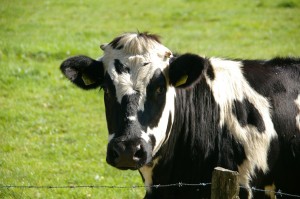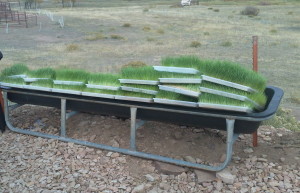Livestock farming is a dynamic industry. It is evolving rapidly based on demands for animal based protein. However, the cost of farming and feeding animals is increasing rapidly as well, and so, feed utilization for livestock needs improving. Here you will find sustainable methods of feeding your livestock for maximum efficiency.
Feeding animals the right kind of food with minimum cost is a constant challenge for farmers. Your feed has to be of high quality and cost effective. However, there has been many controversies going on around the world regarding livestock feed.
The problems
The problem with livestock farming is that it requires resources to produce feed for animals. Resources such as land for grazing or growing crops for silage and feed; along with other non-renewable resources such as water, fuel, fertilizers etc. are needed. You may have also heard a statement similar to “It takes 7 pounds of grain to produce 1 pound of beef.”
Controversies have also been going around regarding feeding animals GMO crops and welfare of animals in feedlots, where animals are kept in confined overcrowded area and fed unnatural foods to encourage rapid growth and weight gain.
Keeping emission levels low for greenhouse effects, increasing feed to production rate and protecting animals against pathogens and stressors, including adaptation to potential climate change, are real challenges for livestock farmers.
Feeding Cattle & other ruminant animals
 The digestive system of cattle and other ruminant animals is designed to convert fibrous cellulose and other materials into milk or meat. Ruminants chew their cud several times after eating to help in their digestive process. Microorganisms play an important role in their digestion.
The digestive system of cattle and other ruminant animals is designed to convert fibrous cellulose and other materials into milk or meat. Ruminants chew their cud several times after eating to help in their digestive process. Microorganisms play an important role in their digestion.
The best feed for your ruminant animals is pasture grass. Pasture grasses contain all the different types of nutrients your beef or dairy cattle will need. Hay can be a good source of nutrition and supplement when you don’t have enough access to quality pasture. Hay has to be properly grown and cut at the right time, when grasses are still moist and green, before they are mature and dry. They should be cured and carefully stored to prevent weather damage.
“With only grass-fed livestock, individual Americans would still get more than the recommended daily allowance (RDA) of meat and dairy protein” – Cornell Chronicle
Several types of feedstuffs you could use to supplement their diet
- Roughage: Roughage, such as hay, grass, grain hulls, and oilseed hulls are low to intermediate in energy but high in fiber. Protein content may vary depending on the plant species and the maturity stage.
- Grains: Grains are high energy food with moderate amounts of protein in them. Examples are corn, barley, and oats.
- Oilseed: Oilseeds are high in protein. They do not contain a significant amount of fiber. Example – soybeans.
- Byproducts: Distillers grains, sweet corn cannery waste, bakery waste, grain screenings, contain variable nutrients and moisture.
A combination of grasses, hay and supplementary feed such as roughage, grains, oilseed, and byproduct feed could be used to balance their diet and meet all their daily diet requirements. For proper rationing of feed, the breed of the cattle, the weight, frame size, body condition, desired rate of gain, and stage of production, all needs to be taken into consideration.
“A properly formulated ration supplies adequate amounts of all nutrients to allow cattle to achieve a desired level of production” – Basic Beef Cattle Nutrition
Microgreens
 If you don’t have enough pasture grass or hay, you can grow a wide variety of young juicy and luscious microgreen grasses yourself. With the microgreens fodder system you could very easily and quickly grow a wide variety of grasses such as alfalfa, barley, and wheat indoors, using an aquaponic system. They need very little water and attention from you. Microgreens are higher in nutritional value than full grown grasses and hay, and they are also easily digested. They provide a well balanced nutritious diet for your animals, which they will need to grow strong and resilient, during the cold weather in early spring.
If you don’t have enough pasture grass or hay, you can grow a wide variety of young juicy and luscious microgreen grasses yourself. With the microgreens fodder system you could very easily and quickly grow a wide variety of grasses such as alfalfa, barley, and wheat indoors, using an aquaponic system. They need very little water and attention from you. Microgreens are higher in nutritional value than full grown grasses and hay, and they are also easily digested. They provide a well balanced nutritious diet for your animals, which they will need to grow strong and resilient, during the cold weather in early spring.
Conclusion:
Forages such as pasture grasses and hay are the most natural feed for ruminant animals. They are less likely to face digestive problems if they consume a diet high in natural forage. Especially pasture is the most economical source of nutrients for ruminants. Supplements such as grains, roughage, and byproducts can be used to provide additional nutrients that the pasture grass does not contain. Some high producing animals may need diet supplements in higher quantities, more often.
Have you tried our DIY systems? If you have, please provide us your feedback on it. If you haven’t tried it, now is the best time to obtain a DIY system and try it yourself. Click here to get DIY plans for proven livestock feeding systems.
To obtain your DIY system and seeds please contact us at 303-495-3705 or Click here to book a meeting with us. You can also get your Feed in A Box Microgreens (fodder) from us to see how great it is!!
If you would like to learn more about it, please leave your questions or comments in the comment box below or visit our Facebook Page and leave your comment there.
Source: Sustainable Livestock Nutrition
Related articles and resources:
- Sustainable Livestock Feed- Energy & Nutrition | Sustainable Livestock Nutrition
- Feeding Cattle & Others – Sustainable Livestock Nutrition | Sustainable Livestock Nutrition
- Basics of Feeding Beef Cattle – Sustainable Livestock Nutrition | Sustainable Livestock Nutrition
- Fodder For Livestock – Make Your Own DIY Sprouted Fodder System | Sustainable Livestock Nutrition
- Basic Beef Cattle Nutrition
- Alternative Feeds for Beef Cattle | Publications and Educational Resources | Virginia Tech
- Microgreen – Growing Fodder With DIY Hydroponics System | Sustainable Livestock Nutrition




ray ban sunglasses
And fourth, well, it doesn’t injure that his ideal garbage disposal reviews consumer repirts (profiles.wordpress.org) disposal looks truly excellent.
Thanks for all of the info. I like the fact that the plants don’t need to be hdnreaed off either I’m such a novice gardener; anything that makes plant survival easier works for me! I just finished digging out a couple more plastic containers to start more seedlings next to the house in the sun.